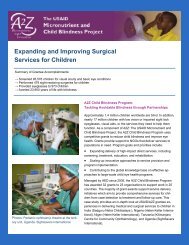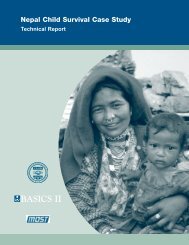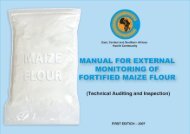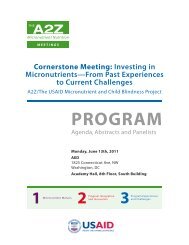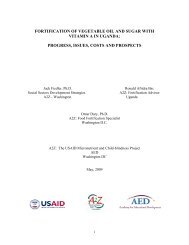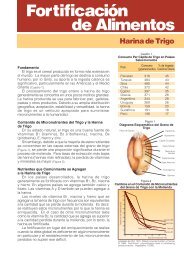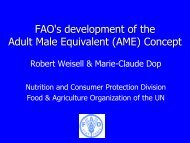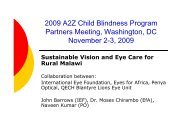Seeing the World through New Lenses: Providing ... - Seva Foundation
Seeing the World through New Lenses: Providing ... - Seva Foundation
Seeing the World through New Lenses: Providing ... - Seva Foundation
You also want an ePaper? Increase the reach of your titles
YUMPU automatically turns print PDFs into web optimized ePapers that Google loves.
<strong>Seeing</strong> <strong>the</strong> <strong>World</strong> <strong>through</strong> <strong>New</strong> <strong>Lenses</strong>:<br />
<strong>Providing</strong> Refractive Error Services to Children in Need<br />
Summary of Grantee Accomplishments:<br />
→ Screened over 950,000 children for visual acuity and basic eye conditions<br />
→ Referred nearly 14,000 children with visual impairment for additional services<br />
→ Provided eyeglasses to over 20,000 children<br />
A2Z Child Blindness Program: Tackling Avoidable<br />
Blindness <strong>through</strong> Partnerships<br />
Doctors in Quang Nam, Vietnam exchange knowledge<br />
and skills on pediatric ophthalmology.<br />
Approximately 1.4 million children worldwide are blind. In addition,<br />
nearly 17 million children with low vision or impaired sight lack <strong>the</strong> eyeglasses,<br />
visual aids, or services <strong>the</strong>y need to help <strong>the</strong>m function. As a<br />
component of A2Z: The USAID Micronutrient and Child Blindness Project,<br />
<strong>the</strong> A2Z Child Blindness Program uses competitive grants to reduce<br />
child blindness and improve eye health <strong>through</strong> support to NGOs<br />
that deliver services to populations in need. The goals and priorities of<br />
<strong>the</strong> program are to:<br />
• Expand delivery of high-impact direct services, including screening,<br />
treatment, and education and rehabilitation.<br />
• Scale-up innovative approaches to service provision and program<br />
implementation.<br />
• Contribute to <strong>the</strong> global knowledge base on effective approaches to<br />
large-scale child eye health programs.<br />
Managed by AED since 2005, <strong>the</strong> A2Z Child Blindness Program has<br />
awarded 37 grants to 24 local and international organizations to support<br />
work in 27 countries across Latin America, Asia, and sub-Saharan Africa.<br />
The majority of grant awards support service delivery initiatives<br />
that provide comprehensive services for children, from case detection<br />
and treatment to follow-up care. The following case study provides an<br />
in-depth look at delivering refractive error services to children in Cambodia<br />
(<strong>Seva</strong>/Cambodia), Nepal (Himalayan Cataract Project, <strong>Seva</strong>/<br />
Nepal), and Vietnam (Fred Hollows <strong>Foundation</strong>).<br />
Refractive Errors: A Leading Cause of Childhood<br />
Blindness<br />
Globally, 12 million children ages five to fifteen are visually impaired<br />
because of uncorrected refractive errors—a leading cause of avoidable<br />
child blindness.<br />
Many of <strong>the</strong>se common visual impairments, including astigmatism, farsightedness,<br />
and near-sightedness, are easily diagnosed and corrected<br />
with glasses, contact lenses, or refractive surgery. <strong>Providing</strong> eyeglasses<br />
to children is one of <strong>the</strong> simplest, most cost-effective measures<br />
for treating refractive errors.<br />
Children await refractive error screening in Quang<br />
Nam, Vietnam.<br />
2
2<br />
Despite this, barriers to access, affordability, and acceptance,<br />
as well as a lack of funding, human resources, and<br />
political commitment, prevent vulnerable children from receiving<br />
<strong>the</strong> refractive eye care services <strong>the</strong>y need to reach<br />
<strong>the</strong>ir human potential. Without glasses and refractive error<br />
services, a child’s vision, education, future productivity, employment<br />
opportunities, and quality of life are negatively<br />
impacted.<br />
The grantees featured in this case study—Himalayan Cataract<br />
Project, <strong>Seva</strong> <strong>Foundation</strong>, and <strong>the</strong> Fred Hollows <strong>Foundation</strong>—used<br />
a combination of school and community-based<br />
refractive error programs to successfully screen, refer, and<br />
provide glasses and eye care services to 950,000 children in<br />
need from April 2008—March 2010, exceeding established<br />
targets. With an eye towards quality service delivery, building<br />
sustainable referral networks, creating local partnerships,<br />
and cross-sectoral collaboration, grantees were able<br />
to provide eye care services to children, families, and communities,<br />
improving <strong>the</strong> quality of life of thousands of children<br />
in Nepal, Cambodia, and Vietnam.<br />
Identifying Children with Refractive Errors<br />
<strong>through</strong> Screening<br />
In all countries, grantees worked with existing eye programs<br />
available at community health clinics and hospitals, and built<br />
upon <strong>the</strong>se structures to establish eye screening services at<br />
schools and in communities. The projects were able to reach<br />
large numbers of children using a strategic combination of<br />
school and community approaches, and by creating referral<br />
networks and linkages between <strong>the</strong> education and health<br />
sectors. School screening programs use existing school<br />
structures and human resources to reach thousands of children<br />
at a low cost. Community screening programs enable<br />
projects to reach <strong>the</strong> hard to reach, including out-of-school<br />
children and <strong>the</strong>ir families, and those living in remote or rural<br />
areas.<br />
School Screening Programs<br />
Prior to implementation, projects collaborated with local eye<br />
clinic and hospital personnel, and <strong>the</strong> necessary village,<br />
district, and provincial level education authorities to establish<br />
school screening programs in Nepal, Cambodia, and Vietnam.<br />
This collaboration allowed projects to build sustainable<br />
referral networks between schools and hospitals, and ensured<br />
that children receive quality vision services <strong>through</strong><br />
school-based screening programs.<br />
A2Z grantees work with local clinic and hospital personnel to<br />
train teachers and equip <strong>the</strong>m with vision charts, referral<br />
slips, and visual acuity training. Once teachers are trained,<br />
projects work with schools to establish and publicize vision<br />
screening schedules. During school screening days, children<br />
are screened by <strong>the</strong>ir teachers and are referred to nearby<br />
community eye clinics or hospitals as necessary.<br />
In remote areas of Nepal and Cambodia that have minimal<br />
access to eye clinics and hospitals, <strong>Seva</strong> sends optometrists,<br />
ophthalmic assistants, or refraction nurses to visit<br />
schools and provide refraction to children who have been<br />
referred by <strong>the</strong>ir teachers.<br />
These eye health personnel <strong>the</strong>n return to schools with<br />
glasses for children who need <strong>the</strong>m, and provide follow-up<br />
care to children as necessary. Overall, projects found that in<br />
-school screenings identified more children in need of<br />
glasses than surgery.<br />
Community-based Screening Programs<br />
Projects also collaborate with local clubs, NGOs, women’s<br />
groups, community leaders, and local eye clinics and hospitals<br />
to coordinate all aspects of community screening programs<br />
and establish community “screening camps”. Some<br />
grantees, like <strong>Seva</strong>, employ a “whole family approach” to<br />
community screening programs, conducting both pediatric<br />
screening camps (for children only), as well as community<br />
screening camps, which include visual screening for adults.<br />
Table 1: Screening Strategies by Organization<br />
<strong>Seva</strong>/Nepal works with school authorities to select teachers<br />
for training who are highly motivated, and those who teach<br />
health or work with youth clubs. Similarly, Fred Hollows<br />
<strong>Foundation</strong> in Vietnam selects screeners who are health<br />
teachers, school medical staff, staff working with <strong>the</strong> school<br />
founder, head teachers, or teachers recommended by <strong>the</strong><br />
school management board. In Cambodia, <strong>Seva</strong> seeks<br />
teachers who have vision problems or wear glasses <strong>the</strong>mselves,<br />
offering <strong>the</strong>m free glasses as an incentive to participate.<br />
Organization<br />
Fred<br />
Hollows<br />
<strong>Foundation</strong><br />
Vietnam<br />
Himalayan<br />
Cataract<br />
Project<br />
<strong>Seva</strong>/<br />
Cambodia<br />
School<br />
teachers<br />
Community<br />
health<br />
volunteers<br />
Traditional<br />
healers<br />
Health<br />
workers<br />
x x x<br />
x x x<br />
x x x<br />
<strong>Seva</strong>/Nepal x x x x<br />
<strong>Seva</strong>’s “whole family approach” helps to ensure that parents<br />
are involved and understand <strong>the</strong> importance of eyeglasses<br />
for visually impaired children, and <strong>the</strong> need for continued<br />
follow-up care.<br />
Grantees regularly select community screeners who are<br />
local, literate, cooperative, and those who are interested in<br />
volunteer work and demonstrate a positive attitude. The<br />
projects prefer to choose individuals who have experience<br />
with visual screening, working with health center staff<br />
and field workers, and who are recommended by provincial<br />
health authorities.<br />
<strong>Seva</strong>/Nepal selects a local organizing committee, which<br />
often consists of individuals from various community-based<br />
groups, to organize screening camps. This committee <strong>the</strong>n<br />
liaises with nearby eye clinics and hospitals to determine <strong>the</strong><br />
date and location of screening camps, hire personnel to conduct<br />
screening and refraction, develop brochures, pamphlets<br />
and o<strong>the</strong>r educational materials, advertise camps on <strong>the</strong><br />
1<br />
2 · Refractive Error Services for Children
3<br />
Doctor Nguyen Ky Suong conducts post-surgical refraction at Binh Son District Hospital in Vietnam.<br />
Quality of Services and Glasses<br />
<strong>Seva</strong>/Nepal uses ophthalmic assistants and optometrists<br />
from community eye clinics and local hospitals to perform<br />
refraction. These personnel receive regular refresher trainradio<br />
and <strong>through</strong> public service announcements, manage<br />
registration, conduct screenings, prescribe treatment, and<br />
provide medicine and glasses at no cost to children who<br />
cannot afford <strong>the</strong>m. Patients needing surgery are referred to<br />
<strong>the</strong> nearest eye hospital.<br />
Similarly, Fred Hollows <strong>Foundation</strong> in Vietnam contacts<br />
local stakeholders to plan screening camps for each commune<br />
in a district. During <strong>the</strong>se scheduled screenings, refraction<br />
is provided by a team consisting of an eye doctor<br />
and a community health worker. Children requiring follow-up<br />
or surgery are referred to nearby clinics and hospitals for<br />
subsequent care and treatment.<br />
<strong>Seva</strong>/Cambodia partners with commune chiefs, monks, and<br />
o<strong>the</strong>r volunteers to inform <strong>the</strong> public that trained field workers<br />
will conduct eye examinations in <strong>the</strong>ir communities at a<br />
specific date and time. When field workers are not available,<br />
<strong>Seva</strong> partners with staff from government eye clinics to conduct<br />
scheduled screenings at nearby community health centers,<br />
temples, or o<strong>the</strong>r locales. All individuals who are identified<br />
as having eye problems are referred to <strong>the</strong> nearest eye<br />
center for in-depth examination and treatment.<br />
The Himalayan Cataract Project employs a door-to-door<br />
approach, and conducts a training of trainers (ToT) at <strong>the</strong><br />
outset of <strong>the</strong>ir community vision screening programs. Eye<br />
clinic and hospital personnel teach traditional healers, female<br />
community health volunteers (FCHVs), and primary<br />
school teachers how to screen and identify children with<br />
visual impairments <strong>through</strong> house-to-house visits. Volunteers<br />
<strong>the</strong>n refer children in need of services to <strong>the</strong> nearest<br />
community eye center or hospital for care and treatment.<br />
According to <strong>the</strong> projects in Nepal, female community health<br />
volunteers (FCHVs) were <strong>the</strong> most effective at identifying<br />
children with visual impairments because <strong>the</strong>y are in regular<br />
contact with <strong>the</strong> community and are familiar with every<br />
household and its health history. As a result, <strong>the</strong>y are able<br />
to ga<strong>the</strong>r information about eye problems quickly and provide<br />
immediate referral for treatment. <strong>Seva</strong>/Nepal found that<br />
traditional healers are able to successfully identify individu-<br />
als with irritated eyes but are not successful at treating eye<br />
diseases. Therefore, <strong>Seva</strong> trained traditional healers to refer<br />
individuals with eye problems to nearby clinics or hospitals<br />
in a timely manner, ra<strong>the</strong>r than trying to treat <strong>the</strong> individual<br />
<strong>the</strong>mselves.<br />
Community screening identified more blind children and<br />
children with serious refractive errors than in-school screening.<br />
Incorporating Eye Health Advocacy and Education<br />
into School and Community-based Screening<br />
Programs<br />
Both Fred Hollows <strong>Foundation</strong> and <strong>Seva</strong> used <strong>the</strong>ir school<br />
and community-based screening programs as platforms to<br />
advocate for increased community focus, commitment, and<br />
resources for eye health. Projects also worked to educate<br />
children and <strong>the</strong>ir families about <strong>the</strong> importance of vision<br />
screening and refractive error services. <strong>Seva</strong>/Nepal provides<br />
a 10-minute presentation for school students after all<br />
children have been screened, while community-based programs<br />
often provide eye health education to children and<br />
<strong>the</strong>ir families during screenings.<br />
All projects encourage and use peer-to-peer, child-toparent,<br />
and parent-to-parent education to stress <strong>the</strong> importance<br />
of getting regular vision exams and immunizations,<br />
good nutrition, proper hygiene, and wearing glasses. As a<br />
result, children inform <strong>the</strong>ir parents, children who do not<br />
attend school, and <strong>the</strong>ir communities on <strong>the</strong> importance and<br />
availability of eye care services. Projects work to educate<br />
and empower children to become eye care advocates by<br />
involving <strong>the</strong>m in all aspects of eye screening.<br />
Ensuring Children with Refractive Errors Receive<br />
Quality Services and Use Eyeglasses<br />
Refractive Error Services for Children · 23
4<br />
who have undergone cataract surgery without an intraocular<br />
lens to replace <strong>the</strong> lens that was removed). For <strong>Seva</strong>/<br />
Nepal, regular lenses can be ground by primary eye care<br />
centers. Aphakic glasses, however, are not often in stock,<br />
and <strong>the</strong> thick lenses are difficult to fit into small frames.<br />
Higher power lenses must be obtained from tertiary hospitals,<br />
which can be located far from where children live.<br />
Barriers to Acceptance<br />
Projects also faced barriers to <strong>the</strong> acceptance of eyeglasses<br />
among children. According to Fred Hollows <strong>Foundation</strong><br />
in Vietnam, children do not like to wear glasses—<br />
particularly <strong>the</strong> thick-framed glasses that are commonly<br />
distributed—because <strong>the</strong>y are ridiculed by <strong>the</strong>ir peers.<br />
Projects work to overcome this challenge by offering a<br />
wide variety of glasses and allowing children to choose<br />
<strong>the</strong>ir own frames. Projects also teach children how to care<br />
for lenses and when to seek help to replace <strong>the</strong>m, giving<br />
<strong>the</strong>m a sense of ownership over <strong>the</strong>ir glasses.<br />
Ophthalmologists working with Fred Hollows <strong>Foundation</strong><br />
conduct refraction in Vietnam.<br />
Training and Selection of Vision Screeners<br />
Experience from <strong>Seva</strong>/Cambodia and <strong>Seva</strong>/Nepal suggests<br />
that screening efficacy varies with a screener’s attitude<br />
and motivation. Dr. A.S. Karthikeyan, a <strong>Seva</strong> trained<br />
pediatric ophthalmologist working in Nepal, said: “Different<br />
levels of motivation among people can affect <strong>the</strong> results. A<br />
well motivated teacher can do a very good job at screenings,<br />
thus ensuring that children receive quality screenings<br />
and refraction services. Fred Hollows in Vietnam<br />
works with reputable glasses suppliers and professional<br />
refractionists or ophthalmologists to ensure <strong>the</strong> accuracy<br />
of lens prescription and quality of frames. In Cambodia,<br />
<strong>Seva</strong> ensures that only refractionists or refraction nurses<br />
from clinics and hospitals write prescriptions for children<br />
with refractive errors.<br />
Barriers to Access<br />
Grantees found that parents who have to travel long distances<br />
with children to reach an eye clinic, or those who<br />
have difficulty locating <strong>the</strong> glasses dispensary inside a<br />
hospital often defer <strong>the</strong> purchase of glasses for children,<br />
or don’t buy <strong>the</strong>m at all. <strong>Seva</strong>/Nepal found that placing <strong>the</strong><br />
glasses dispensary inside <strong>the</strong> pediatric unit where children<br />
receive services often ensures that parents take <strong>the</strong>ir children<br />
to get <strong>the</strong> glasses <strong>the</strong>y need in a more timely manner.<br />
<strong>Seva</strong>/Nepal, <strong>Seva</strong>/Cambodia, and Fred Hollows <strong>Foundation</strong><br />
make services and glasses more accessible to children<br />
by dispensing glasses at schools and o<strong>the</strong>r screening<br />
sites whenever possible, and providing glasses at no<br />
cost to children whose families can not afford <strong>the</strong>m. Using<br />
community-based approaches, all projects work to bring<br />
eye care services closer to poor, rural villages, thus removing<br />
transportation and o<strong>the</strong>r logistical barriers to access.<br />
Although programs did not experience difficulty in obtaining<br />
eyeglasses for lower refractive errors, Himalayan<br />
Cataract Project, <strong>Seva</strong>/Nepal, and <strong>Seva</strong>/Cambodia reported<br />
challenges in getting bifocals, glasses for higher<br />
refractive errors, and glasses for aphakic children (those<br />
1<br />
In Cambodia, <strong>Seva</strong> found that many people believe<br />
glasses actually exacerbate refractive error, and that children<br />
are often afraid that <strong>the</strong>ir parents won’t let <strong>the</strong>m play<br />
computer games or read comic books if <strong>the</strong>y find out <strong>the</strong>y<br />
are having vision trouble. The projects worked to combat<br />
<strong>the</strong>se and o<strong>the</strong>r misconceptions <strong>through</strong> school and community-based<br />
advocacy and education, teaching parents<br />
and children about <strong>the</strong> importance of correcting vision<br />
problems, and indicating that glasses will actually help<br />
children participate in <strong>the</strong> activities <strong>the</strong>y enjoy.<br />
Follow-up<br />
Projects provide quality follow-up care to ensure that children<br />
are wearing glasses and have <strong>the</strong> correct prescription.<br />
Himalayan Cataract Project provides follow-up services<br />
to children with refractive error 6-8 months after <strong>the</strong>ir<br />
initial visit, while children with refractive error and amblyopia<br />
receive follow-up 2 and 4 months later. Teachers<br />
working with Fred Hollows <strong>Foundation</strong> in Vietnam ensure<br />
children are wearing <strong>the</strong>ir glasses in school, and remind<br />
children of <strong>the</strong> importance of periodic follow-up eye exams.<br />
Results<br />
From April 2008—March 2010, <strong>the</strong> projects screened<br />
950,000 children for visual acuity and basic eye conditions,<br />
identified 14,000 children with visual impairment,<br />
and provided eyeglasses to 20,000 children in need. For<br />
every 100 children screened, one child received glasses.<br />
Each of <strong>the</strong>se child eye care programs overcame barriers<br />
to successfully provide quality services, educate <strong>the</strong> public,<br />
and create local partnerships and referral networks.<br />
Lessons Learned and Way Forward<br />
4 · Refractive Error Services for Children
5<br />
ing as it takes a lot of patience to get children to read visual<br />
acuity charts.”<br />
Projects found that it is most cost effective and productive to<br />
have school teachers conduct <strong>the</strong> initial vision screenings of<br />
children, as sending eye clinic and hospital staff to conduct<br />
<strong>the</strong> initial screening is more costly and creates scheduling,<br />
timing, and logistical constraints. Eye clinic and hospital personnel,<br />
for example, are often only available to visit schools<br />
during weekends or holidays when hospital work is slow.<br />
During <strong>the</strong>se times, however, children are not in school.<br />
RP Kandel, Program Manager for <strong>Seva</strong>/Nepal, said,<br />
“Teachers are with <strong>the</strong> children everyday. They see who is<br />
holding <strong>the</strong>ir books close to <strong>the</strong>ir face when <strong>the</strong>y read, who<br />
is having trouble seeing <strong>the</strong> board or squinting. They can<br />
often easily detect <strong>the</strong> children who have impaired vision.”<br />
For community-based screening programs, projects in Nepal<br />
found that FCHVs were highly motivated, familiar with a<br />
household’s health history, and effective at identifying and<br />
referring children in <strong>the</strong> community who are in need of care.<br />
Ongoing support and training for this group will continue to<br />
yield high results in identifying out of school children <strong>through</strong><br />
community-based approaches.<br />
Sustainability of Programs<br />
While pediatric refractive error services can be supported in<br />
part by patient and glasses fees, funding provided by USAID<br />
has been essential for all programs. The government of<br />
Cambodia does not have a pediatric eye care program, and<br />
as a result all free refractive error services for children depends<br />
on external funding. In Nepal, all eye care is overseen<br />
by NGOs; it is unlikely that <strong>the</strong> government will sponsor<br />
a pediatric eye care program. Program activities in Vietnam<br />
can generally be supported by patient fees and eyeglass<br />
sales, however, external funding is needed to provide<br />
glasses to children whose families cannot afford <strong>the</strong>m, as<br />
well as for eye health promotion, equipment procurement,<br />
and <strong>the</strong> training of personnel.<br />
School and community screening programs must continue to<br />
educate <strong>the</strong> entire community about eyeglasses as a corrective<br />
measure for refractive errors, generate demand for refractive<br />
error programs, and advocate for more political commitment<br />
and human resources for vision services. Ongoing<br />
collaboration between village, district, and provincial level<br />
health and education sectors is also key to <strong>the</strong> success of<br />
pediatric refractive error programs. Increased refractive error<br />
education will highlight <strong>the</strong> importance of eye health and<br />
address cultural barriers to wearing glasses.<br />
Program Development and Implementation<br />
The following recommendations should be implemented to<br />
improve <strong>the</strong> quality and coverage of school and communitybased<br />
refractive error programs.<br />
• Generate demand for refractive error services.<br />
• Involve children in eye screening. This will educate and<br />
empower <strong>the</strong>m to become eye care advocates.<br />
• Work to reach children who do not attend school <strong>through</strong><br />
community screenings and door-to-door visits.<br />
• Increase motivation of screeners by offering free or subsidized<br />
eyeglasses and refractive services to teachers<br />
“The project has implemented activities to<br />
raise a profound awareness about childhood<br />
blindness among <strong>the</strong> local community,<br />
from government officials to citizens,<br />
from <strong>the</strong> young to <strong>the</strong> old. The screening<br />
and referral system between schools at <strong>the</strong><br />
district and provincial level is a key pathway<br />
for refractive error management now<br />
and in <strong>the</strong> future.”<br />
-Phan Quoc Bao, Project Manager<br />
Fred Hollows <strong>Foundation</strong>, Vietnam<br />
and community volunteers and health workers who conduct<br />
screenings.<br />
• Use eye care personal trained in refraction techniques to<br />
conduct refraction.<br />
• Provide ongoing follow-up care for children as vision and<br />
prescriptions will continue to change as children mature.<br />
• Integrate education into screening programs. Children<br />
and <strong>the</strong>ir parents should learn about refractive errors and<br />
<strong>the</strong> importance of wearing eyeglasses as a corrective<br />
measure. Detecting refractive errors and prescribing<br />
glasses are not effective unless children receive and<br />
actually wear glasses with <strong>the</strong> correct prescription.<br />
• Emphasize a ‘whole family approach.’ This will ensure<br />
that parents are involved and understand <strong>the</strong> importance<br />
of eyeglasses and continued follow-up care.<br />
• Work with glasses manufacturers and suppliers to address<br />
supply challenges, including <strong>the</strong> procurement of<br />
bifocals, glasses for higher refractive errors, and glasses<br />
for aphakic children. Supplies should be made available<br />
at local clinics and hospitals, not just at tertiary hospitals,<br />
which are often hard to reach.<br />
Policy Development and Fur<strong>the</strong>r Research<br />
The following recommendations will increase access to and<br />
coverage of refractive error services.<br />
• Develop national refractive error guidelines to set standards<br />
for vision screening programs.<br />
• Increase coverage of services by institutionalizing mandatory<br />
vision screening before children can start school.<br />
• Expand knowledge of health practitioners and school<br />
children by including eye health in health textbooks.<br />
Conducting fur<strong>the</strong>r research on <strong>the</strong> ideal age of first screening<br />
children, recommended screening frequency, percentage<br />
of children who receive <strong>the</strong> correct prescription, and<br />
percentage of children who wear <strong>the</strong> glasses <strong>the</strong>y receive,<br />
will be useful for developing high-quality, effective programs<br />
and policies.<br />
Refractive Error Services for Children · 25
6<br />
Beneficiary Mak Rorsynin receives vision screening at BOCC in Battambang, Cambodia (left) and new glasses (right).<br />
Mak Rorsynin, 8 years old, is <strong>the</strong> youngest of<br />
four siblings. Her family lives in Kampong Ampil village<br />
in Battambang Province, located 20 km from <strong>the</strong><br />
Battambang Ophthalmic Care Center (BOCC)—an<br />
implementing partner of <strong>Seva</strong> Cambodia. Rorsynin<br />
began attending school three years ago, but had recently<br />
been having some trouble.<br />
Her teacher reported that Rorsynin did not seem interested<br />
in playing with her friends and always held<br />
her school books close to her face. When Rorsynin’s<br />
parents spoke with <strong>the</strong>ir daughter about her troubles<br />
at school, <strong>the</strong> girl complained that she could not see<br />
<strong>the</strong> blackboard well and was having trouble reading<br />
her books. All of her siblings were doing well in <strong>the</strong>ir<br />
studies, but Rorsynin, frustrated and upset, refused to<br />
return to school for <strong>the</strong> following six months. Her parents<br />
had no idea how to motivate her to go back to<br />
school. They wanted <strong>the</strong>ir daughter to receive a good<br />
education and hoped that she would someday become<br />
a teacher. Both of <strong>the</strong>m worked catching fish in<br />
<strong>the</strong> nearby Sangke River and were uneducated; <strong>the</strong>y<br />
wanted better lives for <strong>the</strong>ir own children.<br />
On December 15, 2008, a field worker from BOCC<br />
met with <strong>the</strong> Kampong Ampil village chief to arrange<br />
a free community eye health screening in <strong>the</strong> village.<br />
The health worker requested <strong>the</strong> chief to ga<strong>the</strong>r vil-<br />
lagers who had eye problems, especially women and<br />
children, toge<strong>the</strong>r on a specific day. When <strong>the</strong><br />
screening day arrived, Rorsynin’s fa<strong>the</strong>r arrived with<br />
his daughter. The health worker examined Rorsynin<br />
and recommended that she visit BOCC as soon as<br />
possible for a more in-depth examination.<br />
The following day, Rorsynin and her fa<strong>the</strong>r hired a<br />
motorcycle taxi and traveled to BOCC. There, <strong>the</strong><br />
ophthalmologist informed <strong>the</strong>m that Rorsynin had<br />
high myopia, and needed eyeglasses to correct her<br />
vision. Her fa<strong>the</strong>r, distressed, explained to <strong>the</strong> doctor<br />
that he and his wife could not afford eyeglasses for<br />
<strong>the</strong>ir daughter. Thanks to <strong>the</strong> support of USAID and<br />
<strong>Seva</strong> <strong>Foundation</strong>, BOCC was able to give Rorsynin a<br />
free pair of glasses to correct her eyesight.<br />
When she put on her new glasses, Rorsynin exclaimed<br />
that she could see more clearly, and proudly<br />
said, “I promise to go to school again, to study regularly,<br />
and to make my parents’ dream come true–I will<br />
be a good teacher!” Rorsynin’s parents were so<br />
happy and expressed <strong>the</strong>ir gratitude to all who helped<br />
<strong>the</strong>ir daughter to get eyeglasses so that she can return<br />
to school. Her parents wanted to share Rorsynin’s<br />
story with everyone in <strong>the</strong>ir community so that<br />
o<strong>the</strong>r people would know to bring <strong>the</strong>ir children for<br />
timely care at BOCC.<br />
This case study is made possible by <strong>the</strong> generous support of <strong>the</strong> American people <strong>through</strong> <strong>the</strong> United States Agency for<br />
1<br />
International Development (USAID) under <strong>the</strong> terms of Cooperative Agreement No. GHS-A-00-05-00012-00. The contents<br />
are <strong>the</strong> responsibility of <strong>the</strong> Academy for Educational Development and do not necessarily reflect <strong>the</strong> views of<br />
USAID or <strong>the</strong> United States Government.



